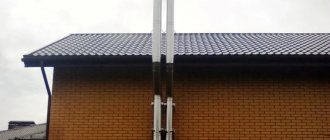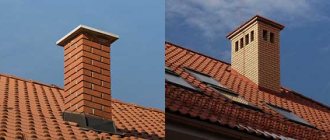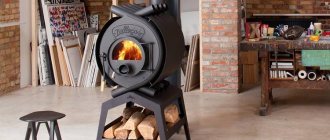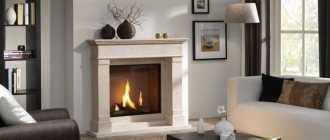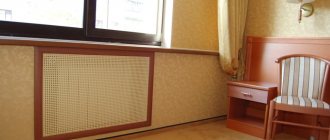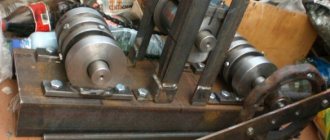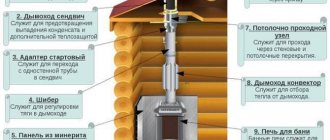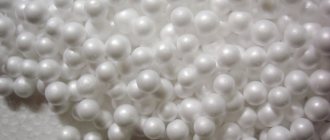Here you will learn:
- Purpose of the deflector
- Operating principle of deflectors
- Design and types of deflectors
- Which deflector is better for a chimney?
- How to make a TsAGI deflector for a chimney pipe with your own hands
- DIY Grigorovich deflector
- Deflector-vane
- How to install a deflector
This is a metal cap made of galvanized or stainless steel that fits onto the top of the chimney or roof vent unit.
The deflector's operation is based on Bernoulli's physical law, according to which, when the lumen of the exhaust pipe narrows, the air flow speed increases. As the flow rate increases, the exhaust gases become rarefied, creating a low-pressure area that produces draft. According to calculations, installing a deflector on a chimney increases the efficiency of the heating system by 20-25%.
The deflector consists of several elements - a metal pipe that is installed on the chimney, a diffuser, an outer ring and a protective element (umbrella).
Important! The design of the deflector is quite simple, and if necessary, you can make it yourself. This requires a sheet of galvanized or stainless steel and fasteners to connect the components together. But you can also purchase ready-made designs in accordance with the diameter and location of the chimney.
Purpose of the deflector
Installing a deflector allows you to solve the following problems.
- Protect the chimney pipe from clogging and moisture. During the off-season period, birds can make nests on it, the chimney becomes clogged with snow, and a large amount of water gets into it when it rains. The deflector completely eliminates the occurrence of such problems.
Without a deflector, the chimney quickly becomes clogged and needs to be cleaned
- Reduce the negative impact of climatic factors on chimney draft indicators. As already mentioned, weather conditions can be so unfavorable that they cause backdraft, a very dangerous phenomenon.
In the presence of reverse draft, smoke and carbon monoxide go into the room and not into the chimney
- Increase the efficiency of chimneys within 15–20%. Due to this, it becomes possible to regulate their minimum length, improve the appearance of the building facade, and reduce the cost of installing elements.
The deflector allows you to minimize the cost of installing a chimney
- Extinguish sparks. This is an additional function of the deflector and is important when determining the fire safety category of the roof.
The deflector extinguishes sparks, preventing accidental fire
The deflector consists of three main elements: a diffuser, an umbrella and a body. The diffuser changes the speed of movement of combustion products in the chimney pipe, the umbrella protects it from water and debris, and the housing cuts through air flows and creates a vacuum to increase draft. There are modifications with an installed protective mesh, but this addition slightly worsens the performance characteristics of the deflector.
Standard deflector design
The action of the deflector is explained by the Bernoulli effect: the speed of air flow has a direct relationship with the pressure in the channel. Air increases the speed of movement in a narrowed diffuser, due to this the pressure in the housing decreases and the draft in the chimney increases.
The mechanism of action of the deflector is based on the Bernoulli effect
Installation features
The location of the deflector directly affects the efficiency of its operation. When installing the structure on a chimney, certain conditions must be observed:
- on a flat roof, the mouth of the chimney should be located above the enclosing elements;
- on a pitched roof, the pipe head is raised above the ridge if the distance between them is less than 1.5 m, and mounted at the same level if the distance is from 1.5 to 3 m;
Elevation of chimneys above buildings
Deflector with adapter for pipe
Operating principle of deflectors
Operating principle of deflectors
The standard device includes three main elements - a cylinder, a diffuser, and a protective cap (umbrella). Additionally, the design is equipped with ring bumpers, which are located in the lower part and around the diffuser. There are several types of deflectors that differ in shape, size and number of elements, but all of them, regardless of type, work on the same principle.
Deflectors
The structure is installed at the very top of the chimney and creates an obstacle to air flow. When the wind hits the walls of the cylinder, it loses its strength and breaks up into many small air currents of low intensity. Some of them rise up the body and capture the smoke coming out of the chimney. This is what increases draft in the chimney duct.
Due to the absence of turbulence, smoke and carbon monoxide do not fall back into the pipe, but are completely removed outside. In addition, the deflector prevents the pipe from clogging through the top and performs decorative functions.
Decorative deflectors
It has been proven that after installing the deflector, the efficiency of the heating device increases by 15-20%. Of course, the deflector itself will not give anything if the chimney is not installed high enough or the cross-section of the connecting pipe is incorrectly selected. The location of the pipe on the roof also matters.
Why does the chimney smoke?
The problem of smoke is due to three reasons:
- Firstly, air currents created by a strong gusty wind enter the chimney and literally crush the smoke rushing upward. As a result, we get smoke in the room and loss of draft.
- Secondly, the cause of smoking may lie in the wrong diameter. This means that a product with a small cross-section is installed.
- Thirdly, smoking occurs when it is placed incorrectly on the roof and the height of the chimney itself is insufficient.
Design and types of deflectors
Despite the existence of many models of deflectors, they are basically built using the following structural elements:
- inlet pipe with nipple or flange connection;
- an outer cylinder, which is called a diffuser;
- housings;
- a cone-shaped cap called an umbrella;
- brackets for attaching an umbrella.
Some deflector designs may use two cones—direct and reverse. The first serves as protection against precipitation, and the second serves to redistribute the flow of combustion products.
Various deflectors have common structural elements
For making deflectors with your own hands, galvanized sheet or stainless steel is best suited. In addition to these materials, the industry has mastered the production of devices with a protective enamel layer or a coating of heat-resistant plastic.
Among the many deflectors that you can make with your own hands, there are several of the most popular designs.
Deflector-vane
This reflector has a rotating part (wind vane), which rotates when the wind direction changes. In this case, the deflector curtain shields the chimney from incoming air masses and contributes to the appearance of vacuum on the leeward side. Thanks to this, active suction of combustion products is carried out, which eliminates backdraft and the formation of sparks.
The deflector with a wind vane can be rotated, orienting the reflector exactly across the direction of the wind
TsAGI deflector
The TsAGI deflector is a universal device that can be installed on any pipe - stove, exhaust or ventilation. Developed at the Central Aerohydrodynamic Institute named after. Zhukovsky device has a simple design with an open flow path and protection against reverse draft. There are two types of TsAGI reflectors, designed for external or internal installation. Thanks to its many advantages, this type of deflector has gained wide popularity among home craftsmen. However, the design is not without its drawbacks. The “weak link” is the narrow passage section, which can be blocked by a layer of ice on the inner cylinder. In addition, the TsAGI deflector is not effective enough in low winds and calm conditions - in these conditions its design creates little resistance to natural draft.
The TsAGI delector has a simple design and excellent performance characteristics
Disc-shaped
This deflector got its name because of several cones (plates) in its composition and refers to devices with an open flow path. The reflector has a protective umbrella combined with a cone and a lower part in the form of a cap with a hole for smoke exit. The vacuum occurs due to the plates directed towards each other, which form a narrowing channel for incoming air flows.
In a disc-shaped deflector, vacuum occurs in the gap between the cones directed towards each other
Round "Volper"
The device has a design similar to the TsAGI reflector. The differences concern only the upper part of the deflector. A cap that protects the inside of the chimney from debris and precipitation is installed on top of the diffuser, which eliminates some of the shortcomings of the device developed at TsAGI. Zhukovsky.
"Volper" has minimal differences from the TsAGI traction amplifier, which provide it with advantages in the absence of wind
Grigorovich deflector
One of the most repeatable designs is the improved TsAGI deflector. The smoke that comes from the chimney passes through the narrowing channel of the diffuser, thereby increasing its flow rate. The Grigorovich deflector is best suited for chimneys installed in lowlands and areas with weak air flow, since it is able to provide good draft even in complete calm.
The Grigorovich deflector is an ideal solution for areas with weak air currents
H-shaped
Deflectors, the silhouette of which resembles the letter “H”, are designed to equip chimneys of powerful stoves and boiler plants. In such devices, the exhaust gas flow is divided into two parts and accelerated out through two side diffusers. The advantages of the design include a significant improvement in traction when air masses move in any direction. In addition, the H-shaped deflector does not require the installation of a canopy, since the mouth of the chimney is protected by the transverse pipe of the device.
H-shaped draft amplifiers are designed for installation on chimneys of powerful heating units
Rotating
The device is made in the form of a sphere with many curved side blades. The presence of blades allows the device to rotate in a certain direction and work like a turbine. Rotary deflectors are best suited for gas boilers and do an excellent job of protecting the chimney from debris and precipitation. The disadvantages of devices of this type are their low efficiency in icing conditions and lack of wind.
Numerous rotating deflector blades create thrust like a turbine
Review of popular models
Let's take a closer look at the most common models of deflectors.
Ventilation deflector Tsaga
This model is considered the most popular. This device has a larger diameter than the chimney. Air flows flow around the device from all sides, as a result of which areas of high pressure are formed on the sides, and a vacuum occurs in the rear and front zones, increasing traction.
The design of such a product eliminates the protection of the chimney duct from precipitation. Therefore, after installing this device, additional installation of a protective cap is required.
The Tsaga deflector is suitable for use in both chimney and ventilation systems
Disc-shaped
A simple model that ensures fairly efficient operation of the system and high traction. The two main elements of the device form a protective canopy that prevents snow and rain from entering the chimney channel.
The lower part of the visor is covered with a cap, which is directed towards the chimney. This design allows the device to cope with the tasks assigned to it. The air flow can enter such a deflector from any side and, finding itself between the cones that form a narrowed channel, cause a vacuum.
Ball-shaped "Wolper"
This model has an almost identical device to the TsAGI deflector. However, there is one difference - the canopy, which protects the chimney channel from precipitation and debris, is located above the diffuser.
Grigorovich deflector
A very popular deflector model that increases draft in chimney and ventilation structures. This deflector is easy to assemble with your own hands. The design of this device includes the following components: a lower cylinder with two pipes, an upper cylinder, a cone and two brackets.
The smoke coming from the pipe ends up in the narrowed channel of the diffuser, causing a vacuum to occur. To assemble such a device, as a rule, a tin sheet or galvanized steel plate is used.
The Grigorovich deflector has a very simple design and is often made by hand
H-shaped
This model is used mainly in manufacturing plants or boiler houses that have high power. The installation of an H-shaped deflector occurs as follows: a pipe of a similar size is attached to the mouth of the pipe. In the central part of the pipe there is a special insert, which ensures a tight connection of the device with the chimney pipe. Two more tubes are fixed to the transverse pipe on the right and left, resulting in a device resembling the letter “H” is formed.
This design does not require a protective canopy, since the mouth of the chimney is already protected by horizontal parts. The H-shaped deflector enhances traction in any direction of air flow.
Rotating
Such a device rotates only in one direction. The circular motion provides additional efficiency of the device. In addition, this model provides protection for the pipe from precipitation and debris. Often used for gas-fired boilers.
Deflector "weather vane"
This model includes a rotating body. This device includes the following elements: weather vane, visors, bearing assembly. The rotation of the device is carried out due to the force of the wind acting on the weather vane. The weather vane type chimney deflector works on the principle of a ship's sail.
The weather vane deflector has a part in its design that rotates when the wind blows
The operating features of the device are as follows: air flows pass between the visors, so the air becomes rarefied. This model allows you to increase draft in the chimney, eliminate reverse draft and the formation of sparks.
Which deflector is better for a chimney?
The choice of reflector is a purely personal matter. Most often they use TsAGI - reliable and unpretentious, suitable for both chimneys and ventilation pipes.
Is it possible to install a deflector on a gas chimney? Need to. You will not only save fuel and increase the efficiency of your gas boiler, but you will also receive additional increase and stabilization of draft and a reduction in the likelihood of reverse draft - a dangerous phenomenon that can occur on very windy days and lead to poisoning by combustion products.
The most important question
Before selecting or making a deflector for a pipe, you need to decide - is it needed at all? The deflector may freeze, be covered with soot or carbon deposits (coked), clogged with fallen leaves, wind-blown debris or dust. In any of these cases, if the deflector is on the chimney, the inhabitants of the house are at risk of getting burned. The deflector does not increase the efficiency of a furnace or boiler much, but it requires regular inspection and cleaning. At least once every 3 months for solid fuel stoves and at least once every six months for gas, liquid fuel or pyrolysis stoves and boilers. For more information on the dangers that can result from installing an unsuitable deflector on a pipe, see the video:
Video: what are the dangers of deflectors, umbrellas and weather vanes on a chimney?
Therefore, if you have an old wood or coal stove, but the draft is not good and the wind is blowing into the chimney, instead of a complex deflector it is better to install a simple chimney, for example. umbrella or tent. And in other cases, you need to thoroughly understand which deflector is needed for this particular stove/boiler with this particular chimney. It is also important not to confuse a smoke deflector with a ventilation one - small traders and the authors of some popular publications do not see or do not make the difference between them.
How to make a TsAGI deflector for a chimney pipe with your own hands
The process of developing and assembling a deflector for a chimney consists of four stages: drawing, creation of blanks, assembly, installation of the structure and its fastening directly to the chimney.
Required Tools
You will definitely need:
- a sheet of thick paper for drawing and layout;
- marker for marking;
- riveter for connecting structural elements;
- metal scissors for cutting out parts;
- drill;
- hammer.
The choice of base material depends on the design and type of device. When creating static deflectors for a round chimney pipe at home with your own hands, it is best to use sheet metal. Galvanization is the most commonly used, it is affordable and durable.
Don’t forget about the necessary tools before installing the deflector
Development of a drawing of a TsAGI deflector model
There is an algorithm for how to make a deflector for a chimney pipe with your own hands. It is recommended to perform the first stage on paper. First you need to calculate the dimensions of the diameter of the nozzle and the upper cap of the structure, and also calculate the height of the reflector.
For this, special formulas are used:
- diameter of the upper part of the deflector - 1.25d;
- outer ring diameter - 2d;
- height of the structure - 2d+d/2;
- ring height – 1.2d;
- diameter of the cap - 1.7d;
- the distance from the base to the edge of the outer casing is d/2.
Where d is the diameter of the chimney.
To make the task easier, a table containing ready-made calculations for standard sizes of metal pipes will help.
| Chimney pipe diameter, cm | Outer casing diameter, cm | Height of outer casing, cm | Diffuser outlet diameter, cm | Cap diameter, cm | Installation height of the outer casing, cm |
| 100 | 20.0 | 12.0 | 12.5 | 17.0…19.0 | 5.0 |
| 125 | 25.0 | 15.0 | 15.7 | 21.2…23.8 | 6.3 |
| 160 | 32.0 | 19.2 | 20.0 | 27.2…30.4 | 8.0 |
| 20.0 | 40.0 | 24.0 | 25.0 | 34.0…38.0 | 10.0 |
| 25.0 | 50.0 | 30.0 | 31.3 | 42.5…47.5 | 12.5 |
| 31.5 | 63.0 | 37.8 | 39.4 | 53.6–59.9 | 15.8 |
If the chimney has a non-standard width, then all calculations will have to be done independently. But, knowing the formulas, it is easy to measure the diameter of the pipe and determine all the necessary indicators to use them when drawing up drawings.
The further ease of assembling the structure will depend on the correctness and accuracy of the paper patterns. It is required to prepare drawings for the main parts: diffuser, inlet, ring and umbrella.
When the patterns are made, it is recommended to first assemble a paper prototype of the future reflector. Even if you are an experienced craftsman and are sure that you can design a deflector for a stove chimney with your own hands without any problems, you should not skip this stage, since it will help you identify possible errors and shortcomings, and correct the calculations or drawing. Only after creating the correct paper layout, which confirms that the deflector diagram is accurate, can you move on to the next stage.
Step-by-step instruction
There is an order of work that must be followed, otherwise you will not be able to connect the individual parts of the chimney deflector yourself with your own hands.
The procedure is as follows:
- Using paper blanks, transfer the template to the surface of the metal from which you plan to make the reflector. Carefully trace the outlines of the paper parts. You can use a permanent marker, special chalk, or even a simple pencil for this purpose.
- Using metal scissors, cut out the blanks of the necessary structural parts.
- Along the entire contour of the cuts, the metal must be bent by 5 mm and carefully passed with a hammer.
- Roll the workpiece into a cylinder shape, drill holes for fasteners so that you can connect the structure with rivets. Welding is permitted, but not arc welding. You need to be careful not to burn the metal. Choose the distance between the main fastening points from 2 to 6 cm, it varies depending on the size of the finished structure. The outer cylinder is rolled up and fastened in the same way.
- By bending and connecting the edges, make the remaining parts: an umbrella and a protective cap in the form of a cone.
- You need to cut fastening elements from a galvanized sheet - 3-4 strips: width 6 cm, length - up to 20 cm. Bend them along the entire perimeter on both sides and go over them with a hammer. From the inside of the umbrella, you need to drill mounting holes, stepping back from the edge by 5 cm. 3 points will be enough. After this, secure the metal strips to the cap with rivets. Then they must be bent at an angle of 90 degrees.
- Connect the diffuser and cone using rivets to the inlet pipe. Having made a deflector for a round pipe with your own hands, you can begin installing it.
A Volper chimney deflector can be created using a similar method. Its design is very similar to the TsAGI model, but there are some differences in the upper part. They are also made of stainless steel, galvanized or copper.
Self-production of the device
To work you will need:
- galvanized or stainless steel sheet 0.5-1 mm thick;
- metal scissors;
- riveter;
- drill;
- a sheet of thick paper or cardboard.
The most important stage is drawing up a drawing. To do this, you need to measure the internal diameter of the chimney and calculate the product parameters according to the table.
size table
Deflector calculation
If the internal diameter of your chimney differs from the parameters given in the table, calculations are performed as follows:
- the diffuser width is 1.2 d;
- width of the protective umbrella – 1.7-1.9 d;
- the total height of the structure is 1.7 d.
Both measurements and calculations must be as accurate as possible so that there are no difficulties during the installation of the structure and its subsequent operation. If the pipe has a square cross-section, then the deflector must be made square, although the angularity of the body slightly reduces the efficiency of the device.
| Step, No. | Description | Illustration |
| Step 1. | A life-size drawing of the deflector parts is made on paper and cut out. | Drawing Paper cut parts |
| Step 2. | The blanks are fastened and fitted to each other. If all the elements match, you can begin cutting the galvanized sheet. | Preparing for cutting |
| Step 3. | The templates are laid out on galvanized sheets, carefully outlined with a marker, and cut out with metal scissors. On the cuts, the metal is bent 5 mm with pliers and tapped with a hammer. | |
| Step 4. | In places of bends, the metal must be riveted with a hammer to make the edges thinner. | |
| Step 5. | The diffuser blank is rolled into a cylinder, holes for fasteners are drilled and connected with bolts or rivets. You can also use welding, but not arc welding, but semi-automatic, so as not to burn through the metal. | Rolled blank |
| Step 6. | The outer cylinder is made in the same way. Next, the cap blank is rolled into a cone and also connected with rivets or welding. | Cone blank |
| Step 7 | 3-4 strips 6 cm wide and up to 20 cm long are cut out of galvanized steel. The strips are folded along both sides and tapped with a hammer along the entire length. From the inside of the cap, stepping back about 5 cm from the edge, drill the required number of holes for the bolts around the circumference. Fasten the galvanized strips to the cap and give them a U-shape. | Fastening strips Bend strips |
| Step 8 | Using these homemade brackets, the cap is attached to the diffuser, and then the entire structure is inserted into the shell. | Assembly of parts |
If the design must have a reverse cone (Grigorovich deflector), the diameter of the protective umbrella is made 3-4 cm larger than the diameter of the cone. After assembling both elements, the cone is applied to the inside of the umbrella and outlined around the perimeter with a marker. Then make two cuts on the protruding part of the umbrella and bend the resulting strip inward. In the same way, make another 6-8 strips at an equal distance from each other, bend them inward and securely fix the reverse cone without additional fasteners or welding.
Grigorovich deflector diagram
It is more convenient to attach a cap with a reverse cone to the diffuser with construction pins. To do this, before installing the cone on the umbrella, three holes are drilled around its circumference, the ends of the studs are inserted and the nuts are tightened. Then put the umbrella on top and fix the cone in the manner described above. At the top of the diffuser, on the outside, hinges made of tin or aluminum are riveted and the lower ends of the pins are inserted into them. This design withstands strong gusts of wind, serves for a long time and reliably.
In a similar way, you can assemble a deflector of any type, the main thing is to draw up the correct drawing. The only difference will be in the number and shape of parts. The finished device only needs to be mounted on the chimney.
Wind deflectors
DIY Grigorovich deflector
The most popular type of smoke vent is the Grigorovich deflector. It has a simplified design and therefore can be created with your own hands without much difficulty.
The lower cylinder of the Grigorovich deflector includes several pipes. In addition to it, the main parts of this type of weather vane are the upper cylinder, the conical element and two brackets for attaching the product to the chimney.
It is more reasonable to create the Grigorovich deflector from tin and steel, coated with zinc or created specifically for the manufacture of boilers. The recommended material thickness is 0.5 mm.
The most important parts of the Grigorovich deflector are the diffuser, cap and reverse cone
Despite the excellent ability of the Grigorovich deflector to enhance draft and protect the chimney from the penetration of foreign objects, it has one significant drawback - poor performance in low wind conditions.
The Grigorovich deflector is manufactured in stages:
- Prepare tools (tape measure, ruler, felt-tip pen, cardboard, metal scissors, drill, drills and screws) and materials (metal sheets and strips).
- Determine the dimensions of the device. Wanting to simplify calculations, they use formulas for the ratio of deflector parameters. According to them, the height of the deflector is 1.6 times the diameter of the chimney, the width of the diffuser is 1.2 times the diameter of the smoke channel, and the width of the hood is equal to two diameters of the chimney.
- A drawing of each part is drawn up on a cardboard sheet. The resulting templates are cut out and connected to each other, checking that their dimensions correspond to the correct parameters.
- After making sure there are no errors, the contours of all cardboard parts are traced on metal sheets. The blanks are cut out with metal scissors.
- By folding one of the parts, a cylinder is formed - the diffuser body. Two holes are drilled along the edges of the product into which self-tapping screws are inserted.
The first step is to create such a part as the deflector body
- By analogy with the manufacture of the diffuser body, an outer cylinder is created. Next, they make the cap of the device, that is, they roll two metal blanks into cones, and their edges are joined.
- In the upper cone, which is slightly larger than the lower one, 6 legs are cut out and bent. A lower cone is attached to this product with its edges, which is pre-equipped with claws for connection to the diffuser.
The deflector cap is equipped with legs that will help it connect to the cylinder of the device
- The manufactured umbrella is connected with the legs to the inner cylinder (diffuser). After this, it is placed in the outer cylinder.
The Grigorovich deflector has a simple design
Protection of deflectors from low winds
Due to the presence of this feature of wind flows, deflectors began to be equipped with special protective devices that help increase the level of draft in the pipe in any weather. To do this, an axis is installed inside the chimney on two bearings located at different levels.
A semi-cylindrical screen, a weathervane and a cover are installed on the axis. It is this design that protects the entire chimney from the effects of the lower wind flow.
After the direction of the wind flow changes, the weather vane rotates, thereby closing the chimney from the wrong wind flow. Thus, any direction and strength of the wind is not able to block the path of the exhaust smoke, and the draft in the chimney remains the same power.
Do not forget that the deflectors are designed for round pipes, which can become a problem if you have an old brick pipe with a square cross-section. In order to solve this problem, special pipes are used that act as adapters.
For chimneys with a large square cross-section, which are built for fireplace heating systems, it is necessary to use adapters in the form of spacer legs that connect the pipe and the deflector itself. These legs are made of metal strips that can be galvanized or high-quality painted.
Brick pipes require an appropriate transition with an inlet in the desired direction, which allows you to connect a round deflector and a square chimney. In other words, it is not difficult to secure this element of the chimney system in the presence of any type and shape of chimney structures.
You don’t have to buy a deflector at a hardware store, because you can make it extremely easily with your own hands. To do this, you need to calculate the size and shape of the element, after which you can begin the manufacturing process.
On galvanized steel sheet it is necessary to draw the upper and lower cylinders of the future deflector, which can be easily done using an ordinary pencil. You can cut out the necessary elements using metal scissors, which can easily cope with this task.
Once these two parts have been cut and filed, which is required to properly join the two edges of one part, you can begin to secure these edges. As a rule, a welding machine, bolts or rivets are used for this.
It’s worth noting right away that connecting a galvanized steel workpiece using a welding machine is extremely difficult, because it burns through thin metal quite quickly. It is for this reason that rivets or small bolts are most often used.
The finished cone cap must be secured to the upper cylinder of the deflector. This is done using small brackets made of the same sheet steel. The brackets are secured to the pipe using rivets. Do not forget that the brackets should be attached only to the outer side of the deflector, so as not to create additional interference in the internal part for proper air flow and smoke extraction.
A reverse type cone must be attached to the element umbrella. In addition, the assembly of all parts of the deflector must be carried out directly on the pipe itself, which will allow for high-quality installation and fastening of each individual part of the structure.
Otherwise, it is possible to connect two elements of the system poorly, which will subsequently cause a malfunction of the structure and the entire chimney as a whole. In some cases, it is simply impossible to make this design on your own.
As a rule, this happens with brick chimneys, which require high-quality adapters or stands. From this we can conclude that it is much easier, more profitable and faster to buy this inexpensive element of the system than to try to make it yourself.
It is worth recalling that only galvanized steel can be used to make the deflector, which successfully resists the formation of rust, which negatively affects the life and quality of service of such a system element.
Deflector-vane
The weather vane deflector is assembled from such parts as:
- a half-cylinder that serves as a barrier to strong winds;
- a cover that blocks the entry of various debris into the chimney;
- a canvas that rotates in accordance with the direction of the wind;
- a central axis communicating with each element of the device;
- a thrust bearing that performs the task of additionally securing the device on the smoke duct.
Compared to other draft leveling devices, the weather vane deflector is an improved device. It functions on the principle of a ship's sail. The weather vane deflector features a rotating body that moves under the influence of the wind.
The weather vane deflector is constantly in motion, so it easily improves traction
The manufacture of a weather vane deflector is the following process:
- The lower and upper cylinders are cut and formed from metal sheets. To what will be below, racks are attached to the nuts and bolts. After this, the upper cylinder is attached to the structure, to secure which a clamp is taken. At the edges of the posts, using rivets, a reverse cone is fixed, thereby obtaining a base for the weather vane.
- A fragment 12.5 cm long is cut from a pipe with a diameter of 1.3 cm - a support for the weather vane. One edge of the pipe is supplemented with the thread necessary for fastening. A bearing is inserted inside the product, and two steel strips are welded on the sides, tilted in the same way as a dome. It is important that the plates do not become obstacles to the movement of the structure in a circle.
To install the bearing, a thread must be made on the pipe
- Using a compass, they install a compass rose - steel rods on which the letters are attached. The rotating structure is covered with a cap in order to block moisture from entering the housing.
- A cap made of steel and shaped like an arrow is put on the pipe thread. A flag with a counterweight is attached to it.
In fact, a weather vane deflector is an improved version of a conventional device
Popular types of traction enhancers
In modern designs, there are different types of deflectors, so you can choose a model for a house made in any architectural style.
Structurally, these devices differ:
- flat top;
- two slopes;
- semicircular lid;
- folding top.
Each of them has certain advantages: the opening lid on the deflector allows you to control the process of removing combustion products.
A flat top is perfect as a decorative element for a roof made in the Art Nouveau style; the best protection from weather conditions is a gable mini-roof. The material used for their manufacture is mainly galvanized metal, but sometimes it is coated with a layer of plastic or enameled.
How to install a deflector
It is possible to install a deflector on the pipe only if the chimney is made exactly according to the rules of SNiP 41-01-2003, pos. 1 in Fig. below. It is highly desirable that the pipe on which the deflector will be installed is located on the roof slope leeward relative to the direction of the prevailing winds. For reference, leeward means opposite to the direction from which the wind is blowing.
Correct location of the chimney and fastening the deflector to the brick pipe
It is certainly possible to attach the deflector to the otter (the upper extension of the brick pipe) only if the pipe was originally designed for the deflector. If not, or there are even the slightest irregularities in the pipe laying, the deflector must be attached to it as shown in pos. 2 rice:
- A strong sleeve (glass; square-circle adapter) C is inserted into the pipe;
- The glasses are secured with blind anchors A at a level no higher than the bottom row of the otter masonry and with embedded pins Z in the grooves at the mouth of the pipe. Anchors and mortgages are walled up with cement-sand mortar from M200;
- A diffuser/skirt D with a cornice (reflection) K is placed on the glass. Mandatory for a deflector of any design, incl. imperfect!
- The diffuser is attached only to the masonry with small anchor bolts. Not with self-tapping screws in plastic dowels! The skirt/diffuser is not attached to the glass!
- The working structure of the deflector is firmly secured to the collar (top edge) of the skirt/diffuser.
Only with this method of fastening will the deflector never loosen an old and/or undesigned brick pipe.
How to calculate the performance of a turbo deflector
Typically, a turbo deflector is simply placed at the outlet of a vent or chimney without any additional flow analysis, and the base value is used to calculate the performance of the turbo deflector. This value is indicated by the manufacturer in the labeling of the turbomachine; for example, the most popular model TD 400, according to its passport, has a capacity of 400 m3/h with a base wind speed of 2 m/s.
To calculate the required number of turbo deflectors, it is enough to take the required air exchange rate in the room and multiply the coefficient by the volume of the room. Next, the resulting value in cubic meters of air is divided by the basic performance of the turbo nozzle, and the number of devices is obtained.
Assembling a simple dish model
The easiest project to implement is making a dish-shaped deflector model. You can easily make such a chimney cap yourself. Its geometric parameters depend on the diameter of the pipe:
Image gallery
Photo from
Deflector design for round pipe
Diameter of the clamp for mounting the deflector
Chimney cap size
Distance between umbrella and mounting clamp
In order not to make mistakes in manufacturing and to accurately adjust the parts to the required size, it is advisable to first make a model of the deflector from cardboard. At this stage it is simpler and easier to make adjustments to the design. Cardboard blanks will also serve as a kind of patterns when cutting out the elements of the future deflector:
Image gallery
Photo from
Making a pattern for a chimney deflector
Assembling a metal chimney umbrella
Device of remote racks
Attaching the deflector fixing clamp
Main types
Specialized stores offer many design options. Which deflector is best to choose for a chimney will depend on the type of boiler. Very often simple models are made by hand in order to save money. The most popular reflectors include the following devices:
- TsAGI is considered the most popular device. It has a cylindrical shape. This reflector is made of stainless steel or galvanized. Depending on the type of connection, it can be either nipple or flange. The main advantage is a convenient location for removing air masses through ventilation ducts, which improves traction. Through this design, smoke quickly exits the chimney. Disadvantages include difficulty in manufacturing.
- The round Volper is very similar to TsAGI, but it has differences in the upper part. A protective canopy is installed there against various contaminants and precipitation. The most current model for baths is made of stainless steel, galvanized and copper.
- The Grigorovich reflector is the most affordable option, so it is often made with your own hands. The simple design consists of upper and lower cylinders, a cone, pipes and brackets for fixation. The simplicity of the device is its main advantage, but the disadvantage is the high location of the umbrella, which contributes to the side blowing of smoke.
- The H-shaped reflector is suitable for installation with pipe sections, which allows it to withstand maximum wind loads. The main parts of the device are mounted in the form of the letter H. This feature prevents dirt and precipitation from entering the pipe due to the horizontal location of the pipe. Vertically arranged side elements improve internal draft, resulting in smoke being discharged in different directions at the same time.
- A weather vane is a device with a rotating body fixed at the top of the chimney. It is made of stainless steel or carbon steel. Canopies that cut through the air currents of the wind are designed to improve draft in the chimney. They also serve to protect boilers and furnaces from contaminants coming from outside. The disadvantage of the device is the fragility of the bearings that promote the movement of the visors.
- The dish reflector can also be classified as the simplest and most affordable deflector. It protects the chimney system well and provides strong draft. To prevent dirt and precipitation from getting into the pipe, the device is equipped with a special visor. In its lower part there is a cap directed towards the pipe. Internal draft is improved twofold due to the narrow and rarefied channel into which air masses enter.
Some of the models can be made independently. To do this, you must have working drawings with the specified dimensions. The required values can be obtained after measuring the internal diameter of the chimney pipe. If there are inaccuracies in the parameters, then difficulties will arise during installation of the device and during its further operation.
Installation of products is carried out in two ways - on a piece of pipe or on a chimney. The first option is the most convenient, since preliminary work can be done below, and not on the roof, which is safer. Factory products are most often equipped with a lower pipe, which makes the task easier. It is simply put on the pipe and secured with metal clamps.
A reliable deflector will create good draft and help heating equipment operate more efficiently. It will provide safety and comfortable living conditions for all inhabitants of the house during the cold season in all weather conditions.
How does a reflector work?
Deflector in translation means “to reflect.” A reflector is an obstacle to the exhaust gases, changing the direction of their movement. In the simplest model, it looks like a cap covering the diffuser.
Its main components:
- diffuser - the largest cylinder;
- pipe (lower cylinder);
- cap.
The deflector is installed so that it is always blown by the wind.
The principle of operation is based on the Bernoulli effect - when flowing around an obstacle (diffuser), the air speed increases, it becomes more rarefied and helps remove air from the pipe...
Conclusions and useful video on the topic
Is it worth installing a traction amplifier at all if you have a gas boiler? You will find out by watching this video:
Making a turbo deflector with your own hands is not easy, but some craftsmen still do it and successfully operate it. Watch this video:
There are a lot of deflector designs, but we must not forget that gas is used for heating. Not all models can be used. Some of them are not suitable in principle because... designed for ventilation. In order not to block the smoke removal system, you must consult with a specialist and obtain permission to install the deflector.
Looking for a chimney deflector? Or do you have experience in manufacturing or installing this device? Please share it with our website visitors. Also, in the comments block, you can ask questions about the topic of the article.
Do it yourself or order the device
To resolve this issue, you need to take into account all the factors:
- Your requirements for aesthetics, the purpose of the house, the placement of caps relative to the outside of the house;
- chosen design;
- building roof height;
- the ability to independently carry out work at heights (especially if you are afraid of heights), the presence of a ladder on the roof;
- financial condition.
It is possible to make simpler stationary models yourself - the work is quite complex, but accessible.
It is quite difficult to manufacture a rotary structure; it is easier to buy such a model. The parts of such a cap are manufactured with small tolerances and higher accuracy.

